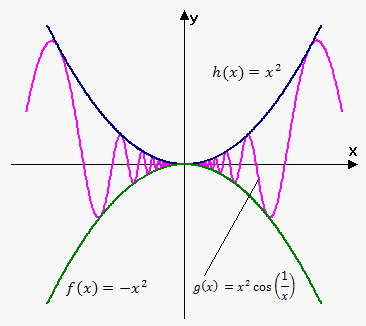Sandwich Theorem
Fact. If $$${f{{\left({x}\right)}}}\le{g{{\left({x}\right)}}}$$$ when $$${x}$$$ is near $$${a}$$$ (except possibly at $$${a}$$$) then $$$\lim_{{{x}\to{a}}}{f{{\left({x}\right)}}}\le\lim_{{{x}\to{a}}}{g{{\left({x}\right)}}}$$$.
This fact means that if values of $$${f{{\left({x}\right)}}}$$$ are not larger than values of $$${g{{\left({x}\right)}}}$$$ near $$${a}$$$, then $$${f{{\left({x}\right)}}}$$$ approaches not larger limit than $$${g{{\left({x}\right)}}}$$$ as $$${x}\to{a}$$$.
Sandwich Theorem (or Squeeze Theorem). Consider three functions $$${f{{\left({x}\right)}}},{g{{\left({x}\right)}}},{h}{\left({x}\right)}$$$. If we have that $$${f{{\left({x}\right)}}}\le{g{{\left({x}\right)}}}\le{h}{\left({x}\right)}$$$, when $$${x}$$$ near $$${a}$$$ (except possibly at $$${a}$$$) and $$$\lim_{{{x}\to{a}}}{f{{\left({x}\right)}}}=\lim_{{{x}\to{a}}}{h}{\left({x}\right)}={L}$$$ then $$$\lim_{{{x}\to{a}}}{g{{\left({x}\right)}}}={L}$$$.
This theorem tells us folowing: if there are three functions, two of which have same
limit as $$${x}$$$ approaches $$${a}$$$ and third is "squeezed" between them, then third will have to approach same limit as $$${x}$$$ approaches $$${a}$$$ as first two.
Example. Find $$$\lim_{{{x}\to{0}}}{{x}}^{{2}}{\cos{{\left(\frac{{1}}{{x}}\right)}}}$$$.
 Since $$$-{1}\le{\cos{{\left(\frac{{1}}{{x}}\right)}}}\le{1}$$$ for all $$${x}$$$ (actually we are interested only in $$${x}$$$ near 0) then $$$-{{x}}^{{2}}\le{{x}}^{{2}}{\cos{{\left(\frac{{1}}{{x}}\right)}}}\le{{x}}^{{2}}$$$. Since $$$\lim_{{{x}\to{0}}}{{x}}^{{2}}=\lim_{{{x}\to{0}}}-{{x}}^{{2}}={0}$$$ then by Squeeze theorem $$$\lim_{{{x}\to{0}}}{{x}}^{{2}}{\cos{{\left(\frac{{1}}{{x}}\right)}}}={0}$$$.
Since $$$-{1}\le{\cos{{\left(\frac{{1}}{{x}}\right)}}}\le{1}$$$ for all $$${x}$$$ (actually we are interested only in $$${x}$$$ near 0) then $$$-{{x}}^{{2}}\le{{x}}^{{2}}{\cos{{\left(\frac{{1}}{{x}}\right)}}}\le{{x}}^{{2}}$$$. Since $$$\lim_{{{x}\to{0}}}{{x}}^{{2}}=\lim_{{{x}\to{0}}}-{{x}}^{{2}}={0}$$$ then by Squeeze theorem $$$\lim_{{{x}\to{0}}}{{x}}^{{2}}{\cos{{\left(\frac{{1}}{{x}}\right)}}}={0}$$$.
On the figure you can see that $$${{x}}^{{2}}{\cos{{\left(\frac{{1}}{{x}}\right)}}}$$$ is squeezed between $$${{x}}^{{2}}$$$ and $$$-{{x}}^{{2}}$$$.
